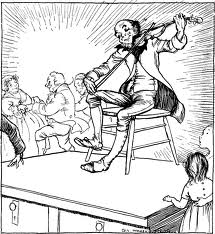
We conclude our account of the dances now most in vogue with an old-fashioned favorite, whose popularity dates from a bygone age, and bids fair to survive the present one. Long may its cheerful rustic strains be heard in our ball-rooms, and prove we have not grown too fine or too foolish to take pleasure in the simple dances of our ancestors. Sir Roger de Coverley is always introduced at the end of the evening; and no dance could be so well fitted to send the guests home in good humor with each other and with their hosts. We describe it as it is danced in the present day, slightly modernized to suit the taste of our time. Like the quadrille, it can be danced with equal propriety by old or young; and is so easy, that the most inexperienced dancer may fearlessly venture to take part in it.
Form in two parallel lines; ladies on the left, gentlemen on the right, facing their partners. All advance; retreat (which occupies the first four bars); cross to opposite places (four bars more); advance and retreat (four bars); re-cross to places (four bars).
The lady who stands at the top, and the gentleman who stands at the bottom, of each line, advance towards each other, courtesy and bow, and retire to places. The gentleman at the top and the lady at the bottom do the same. Lady at top and gentleman at bottom advance again, give right hands, and swing quickly round each other back to places. Gentleman at top and lady at bottom do the same. Top lady advances, gives right hand to partner opposite, and passes behind the two gentlemen standing next to him. Then through the line and across it, giving left hand to partner, who meets her half way between the two lines, having in the meantime passed behind the two ladies who stood next his partner. Lady then passes behind the two ladies next lowest; gentleman at same time behind the two gentlemen next lowest; and so on all down the line. At the bottom, lady gives left hand to her partner, and they promenade back to places at the top of the line. (This figure is frequently omitted.) Top couple advance, courtesy and bow, then lady turns off to the right, gentleman to the left, each followed by the rest of her or his line. Top couple meet at the bottom of figure, join hands, and, raising their arms, let all the other couples pass under them towards the top of the line, till all reach their own places, except the top, who have now become the bottom couple. Figure is repeated from the beginning, until the top couple have once more worked their way back to their original places at the top of the line.
*******
This is taken from Routledge's Manual of Etiquette.
Copyright © D. J. McAdam· All Rights Reserved